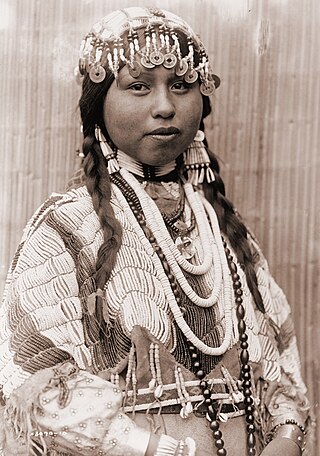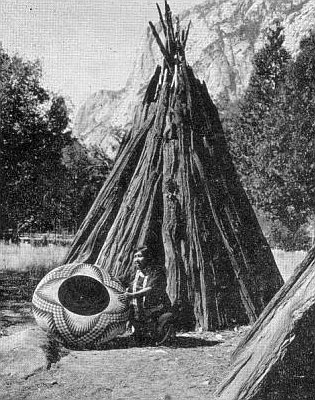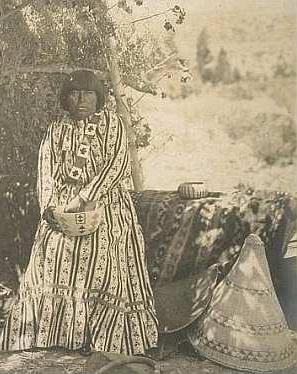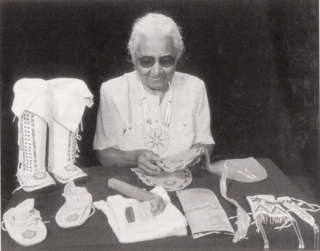
Beadwork is the art or craft of attaching beads to one another by stringing them onto a thread or thin wire with a sewing or beading needle or sewing them to cloth. Beads are produced in a diverse range of materials, shapes, and sizes, and vary by the kind of art produced. Most often, beadwork is a form of personal adornment, but it also commonly makes up other artworks.

Wasco-Wishram are two closely related Chinook Indian tribes from the Columbia River in Oregon. Today the tribes are part of the Confederated Tribes of Warm Springs living in the Warm Springs Indian Reservation in Oregon and Confederated Tribes and Bands of the Yakama Nation living in the Yakama Indian Reservation in Washington.

The Confederated Tribes of Warm Springs is a recognized Native American tribe made of three tribes who put together a confederation. They live on and govern the Warm Springs Indian Reservation in the U.S. state of Oregon.

Lucy Parker Telles was a Mono Lake Paiute - Kucadikadi and Southern Sierra Miwok Native American basket weaver.

The Tenino people, commonly known today as the Warm Springs bands, are several Sahaptin Native American subtribes which historically occupied territory located in the North-Central portion of the American state of Oregon. The Tenino people included four localized subtribes — the Tygh or "Upper Deschutes" divided in Tayxɫáma, Tiɫxniɫáma and Mliɫáma, the Wyam (Wayámɫáma) (Wayámpam) or "Lower Deschutes", also known as "Celilo Indians", the Dalles Tenino or "Tinainu (Tinaynuɫáma)", also known as "Tenino proper"; and the Dock-Spus (Tukspush) (Takspasɫáma) or "John Day."

The visual arts of the Indigenous peoples of the Americas encompasses the visual artistic practices of the Indigenous peoples of the Americas from ancient times to the present. These include works from South America and North America, which includes Central America and Greenland. The Siberian Yupiit, who have great cultural overlap with Native Alaskan Yupiit, are also included.

Juanita Growing Thunder Fogarty is a Native American, Assiniboine Sioux bead worker and porcupine quill worker. She creates traditional Northern Plains regalia.

Martha Berry is a Cherokee beadwork artist, who has been highly influential in reviving traditional Cherokee and Southeastern beadwork, particularly techniques from the pre-Removal period. She has been recognized as a Cherokee National Treasure and is the recipient of the Seven Star Award and the Tradition Bearer Award. Her work is shown in museums around the United States.
Teri Greeves is a Native American beadwork artist, living in Santa Fe, New Mexico. She is enrolled in the Kiowa Indian Tribe of Oklahoma.

Marcus Amerman is a Choctaw bead artist, glass artist, painter, fashion designer, and performance artist, living in Idaho. He is known for his highly realistic beadwork portraits.

Richard Aitson was a Kiowa-Kiowa Apache bead artist, curator, and poet from Oklahoma.

Nellie Charlie (1867–1965) was a Mono Lake Paiute - Kucadikadi basketmaker associated with Yosemite National Park. She was born in Lee Vining, California, the daughter of tribal headman Pete Jim, and his wife Patsy, also a basket maker. She married Young Charlie, a Mono Lake Paiute - Kucadikadi man from Yosemite, and they had six children. Her Paiute name was Besa-Yoona.
Jamie Okuma is a Native American visual artist and fashion designer from California. She is known for beadwork, mixed-media soft sculpture, and fashion design. She is Luiseño, Wailaki, Okinawan, and Shoshone-Bannock. She is also an enrolled member of the La Jolla band of Indians in Southern California where she is currently living and working.
Pat Courtney Gold was a Wasco Native fiber artist and basket weaver from the Columbia River area of Oregon. She graduated with a BA in mathematics and physics from Whitman College and worked as a mathematician-computer specialist before beginning her career in basket weaving. Gold harvested traditional plant fibers to use in her work—including Dogbane, cattail, sedge grass, red cedar bark and tree roots. Her pieces often reflected the natural world along the Columbia River, mixing traditional motifs such as condors and sturgeon with contemporary figures like airplanes. Gold also became an environmental and cultural educator, helping to spread knowledge of her ancestral heritage and basketry skills.

Jackie Larson Bread is a Native American beadwork artist from the Blackfeet Reservation in Browning, Montana. Her interest in bead work was sparked from looking at her late-grandmother's beaded pieces. In awe of these objects, Bread self-taught herself how to bead when she was younger and now, she has been beading for more than 20 years. Continuing through trial and error, Bread has received numerous awards for her beading.

Joyce Growing Thunder Fogarty, is a Native American artist. She is of the Assiniboine Sioux, Dakota people, and is known for her beadwork and quillwork. She creates traditional Northern Plains regalia. The Smithsonian named her as "one of the West's most highly regarded beadworkers".

Alice Littleman was a Kiowa beadwork artist and regalia maker, who during her lifetime was recognized as one of the leading Kiowa beaders and buckskin dressmakers. Her works are included in the permanent collections of the National Museum of Natural History, the National Museum of the American Indian, the Southern Plains Indian Museum, and the Oklahoma Historical Society.
Nellie Two Bears Gates was a Native American artist whose beadwork depicted Yanktonai Dakota history and culture. Beaded suitcases and valises that she gave as gifts are now part of art collections and exhibitions.
Katrina Mitten is a Native American artist. She is enrolled in the Miami Tribe of Oklahoma.














